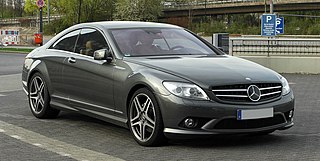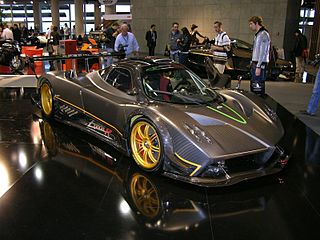
The Lamborghini Diablo is a high-performance mid-engine sports car built by Italian automobile manufacturer Lamborghini between 1990 and 2001. It is the first production Lamborghini capable of attaining a top speed in excess of 200 mph (320 km/h). After the end of its production run in 2001, the Diablo was replaced by the Lamborghini Murciélago. The name Diablo means "devil" in Spanish.

Downforce is a downwards lift force created by the aerodynamic features of a vehicle. If the vehicle is a car, the purpose of downforce is to allow the car to travel faster by increasing the vertical force on the tires, thus creating more grip. If the vehicle is a fixed-wing aircraft, the purpose of the downforce on the horizontal stabilizer is to maintain longitudinal stability and allow the pilot to control the aircraft in pitch.

The Mercedes-Benz SLR McLaren is a grand tourer jointly developed by German automotive manufacturer Mercedes-Benz and British automobile manufacturer McLaren Automotive and sold from 2003 to 2010. When the car was developed, Mercedes-Benz owned 40 per cent of the McLaren Group and the car was produced in conjunction between the two companies. The "SLR" name is an abbreviation for "Sport Leicht Rennsport", and was a homage to the Mercedes-Benz 300 SLR which served as the car's inspiration. The car was offered in coupé, roadster and speedster bodystyles, with the latter being a limited edition model.

The Mercedes-Benz 300 SL is a two-seat sports car that was produced by Mercedes-Benz from 1954 to 1957 as a gullwinged coupé and from 1957 to 1963 as a roadster. The 300 SL traces its origins to the company's 1952 racing car, the W194, and was equipped with a mechanical direct fuel injection system that significantly increased the power output of its three-liter overhead camshaft straight-six engine.
A Formula One car or F1 car is a single-seat, open-cockpit, open-wheel formula racing car with substantial front and rear wings, and an engine positioned behind the driver, intended to be used in competition at Formula One racing events. The regulations governing the cars are unique to the championship and specify that cars must be constructed by the racing teams themselves, though the design and manufacture can be outsourced. Formula One drivers experience peak cornering forces of up to six lateral g.

The Ferrari 599 GTB Fiorano is a grand tourer produced by the Italian automobile manufacturer Ferrari. It served as the brand's front-engined, two-seat model, replacing the 575M Maranello in 2006 as a 2007 model, and was later replaced for the 2013 model year by the F12berlinetta.

A spoiler is an automotive aerodynamic device whose intended design function is to 'spoil' unfavorable air movement across the body of a vehicle in motion, usually manifested as lift, turbulence, or drag. Spoilers on the front of a vehicle are often called air dams. Spoilers are often fitted to race and high-performance sports cars, although they have become common on passenger vehicles as well. Spoilers are added to cars primarily for styling purposes and either have little aerodynamic benefit or even worsen the aerodynamics.

The second generation Mercedes-Benz SLK, internally designated model R171, is a two-passenger, front-engine, rear-drive, retractable hardtop roadster, unveiled at the 74th Geneva International Motor Show—and manufactured and marketed for model years 2004–2010.

The Mercedes-Benz W125 Rekordwagen was an experimental, high-speed automobile produced in the late 1930s. The streamlined car was derived from the 1937 open-wheel race car Mercedes-Benz W125 Formel-Rennwagen, of which also a streamlined version was raced at the non-championship Avusrennen in Berlin.
A glossary of terms relating to automotive design.

The Koenigsegg CCX is a mid-engine sports car manufactured by Swedish automotive manufacturer Koenigsegg Automotive AB. The project began with the aim of making a global car, designed and engineered to comply with global safety and environment regulations, particularly to enter the United States car market. To sell cars in the US, many alterations were made to the design of the CCR; the previously used Ford Modular engine was replaced by an in-house developed Koenigsegg engine designed to run on 91 octane fuel, readily available in the United States, and to meet Californian emission standards.

The Mercedes-Benz C11 is a Group C prototype race car introduced for the 1990 World Sports-Prototype Championship. Built by Sauber as a successor to the Sauber C9, the C11 used the same Mercedes-Benz M119 5.0L twin turbo V8. It was the first time that Mercedes-Benz chose to put their name on the car, instead of simply using Sauber.

The Mercedes-Benz C216 is the last generation for the grand tourer with name Mercedes-Benz CL-Class. It replaced the C215 platform. In 2014 it was replaced by the C217 S-Class Coupe.

The Williams FW30 is a Formula One racing car, designed by Williams for the 2008 Formula One season. The car is largely an evolution of its predecessor, the FW29. As with its predecessor, the FW30 is powered by engines manufactured by Toyota. The FW30 was unveiled to the public on 21 January 2008 at the Circuit de Valencia, Spain, and made its race debut at the Australian Grand Prix and was driven by Nico Rosberg and Kazuki Nakajima.

The Brabus Rocket produced since 2006, is a series of modified vehicles produced by Brabus, a German high-performance vehicle company.

The Ferrari 488 is a mid-engine sports car produced by the Italian automobile manufacturer Ferrari. The car replaced the 458, being the first mid-engine Ferrari to use a turbocharged V8 since the F40. It was succeeded by the Ferrari F8.

The Mercedes-AMG ONE is a limited-production plug-in dual hybrid sports car manufactured by Mercedes-AMG, featuring Formula One-derived technology. The Project One concept car was unveiled at the 2017 International Motor Show Germany by the seven-time F1 world champion and Mercedes-AMG Petronas F1 driver, Lewis Hamilton and Head of Mercedes-Benz, Dieter Zetsche.

The Dallara Stradale is a sports car manufactured by Italian automotive manufacturer Dallara. The Stradale is the first road car manufactured by the company, the company's main products being chassis development for other automobile manufacturers along with the development and construction of race cars. The Stradale is a barchetta in its basic form, with no doors, but is convertible to berlinetta, roadster and targa top body styles after the installation of interchangeable parts.

The Pagani Zonda R is a track day car developed and manufactured by Italian sports car manufacturer Pagani. It debuted at the 2007 Geneva Motor Show, using the 6.0-litre GT 112 engine sourced from the racing version of the Mercedes-Benz CLK-GTR. The Zonda R's competition lies with track-based cars, such as the Ferrari FXX and Maserati MC12 Corsa rather than the original Zonda's road competitors as it is not road-legal.

The GMA T.50 or Gordon Murray Automotive Type 50 is a sports car manufactured by Gordon Murray Automotive. Designed by Gordon Murray and inspired by the McLaren F1, the T.50 is powered by an all-new bespoke 3,994 cc (4.0 L) naturally aspirated V12 engine developed by Cosworth. The engine is rated at 663 PS at 11,500 rpm with a maximum torque of 467 N⋅m (344 lbf⋅ft) at 9,000 rpm.




















